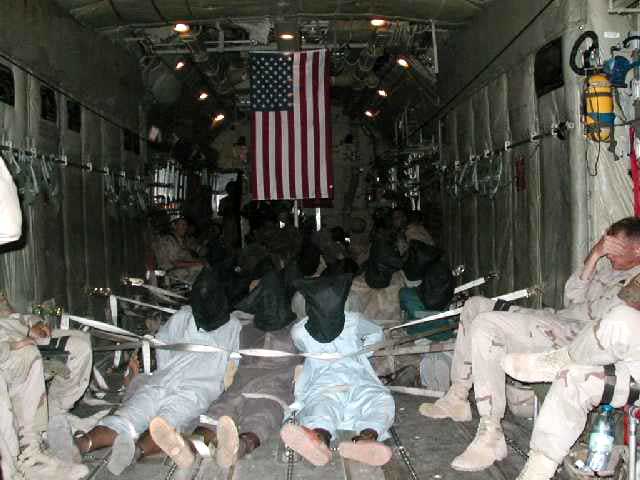Hello all, in our ASTU class we have covered one of the most thought provoking anthology I have read in recent memory: Poems from Guantánamo: The Detainees Speak, edited by Marc Falkoff. The anthology is a collection of poems from detainees expressing their feelings towards their individual situations, and provides a small account of how the detainee came to Guantanamo. Reading about Guantanamo bay from the news is very bias and impersonal. The prisoners are labeled as the most dangerous people on earth, and are treated as such, however, after reading the anthology, I am inclined to feel sympathy for these people, sometimes wrongly detained.

Figure 1: Detainees are subjected to ‘sensory deprivation’ as they are transported and forcefully bound
Today I would like to discuss the ethical issues of torture, using Falkoff’s anthology as a reference. The sympathetic tone of the anthology is bias in itself and I would want to approach the subject without any favoritism.
The detention camp is notorious for attracting public and media attention because of alleged human rights violations. I fail to understand how Gitmo is able to continue operating, even though a majority of testimonies given by detainees tell of how they have been tortured by the US military. One of the reasons for this, I have come across is that post 9/11 Americans could care less about the detainees and some would encourage the use of torture. I would like to take a moment to acknowledge that many reading this would disagree with my generalization and I am sure that many of you would agree that torture should be banned.
Another issue that plagues Gitmo is the force-feeding of detainees. Since 2002, a number of detainees have been on hunger strike in an attempt to protest their innocence. This has led to detainees being restrained in a chair and force-fed, and must remain until the food is digested to avoid induced vomiting. Force-feeding has been declared a form of torture and following the ‘World Medical Association (WMA) Declaration of Tokyo of 1975 [it] prohibits a medical doctor’s participation in torture, whether actively, passively, or through the use of medical knowledge.’(Olshansky and Gutierrez, 5) This produces another issue of nurses being forced, to force-feed the detainees.
Works Cited:
Falkoff, Marc. Poems from Guantánamo the Detainees Speak. Iowa City: U of Iowa, 2007. Print.
Olshansky, Barbara and Gutierrez, Gitanjali (2005-09-08). “The Guantánamo Prisoner Hunger Strikes & Protests: February 2002 – August 2005” Retrieved 2015-02-12.

